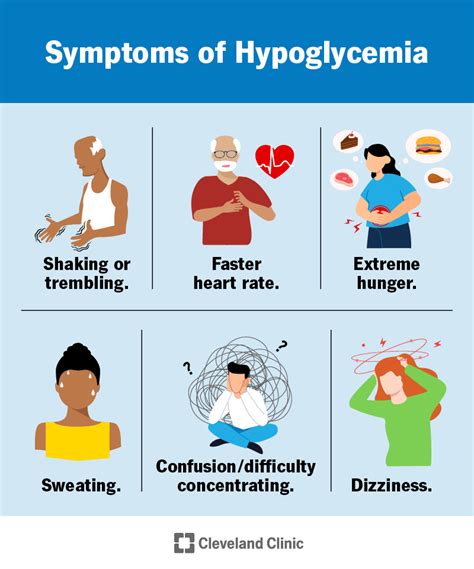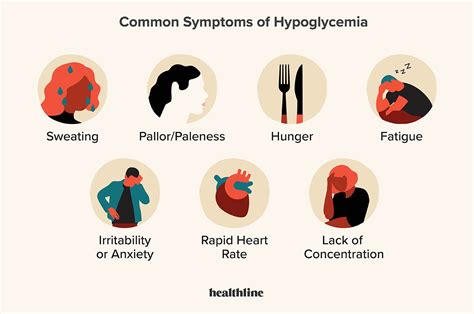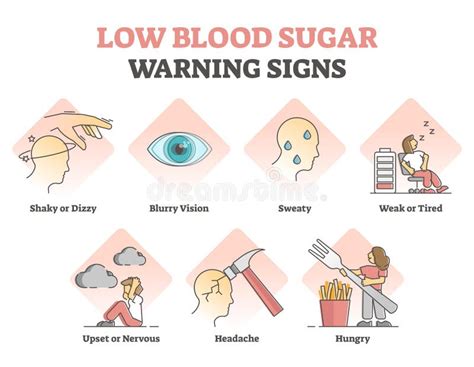Intro
Recognize 7 low blood sugar signs, including shakiness, dizziness, and confusion, to manage hypoglycemia symptoms, glucose levels, and diabetes care effectively.
Low blood sugar, also known as hypoglycemia, is a condition that occurs when the level of glucose in the blood falls below a certain threshold. This can be a serious health issue, especially for individuals with diabetes, as it can lead to a range of complications if left untreated. Recognizing the signs and symptoms of low blood sugar is crucial for prompt intervention and prevention of severe consequences. In this article, we will delve into the 7 low blood sugar signs that you should be aware of, as well as discuss the causes, treatment options, and preventive measures.
The importance of recognizing low blood sugar signs cannot be overstated. Hypoglycemia can strike at any time, and its effects can be swift and devastating. For individuals with diabetes, the risk of low blood sugar is ever-present, particularly if they are taking insulin or other medications that increase insulin production. Even for those without diabetes, low blood sugar can occur due to various factors such as skipping meals, excessive exercise, or certain medical conditions. By being aware of the warning signs, you can take immediate action to prevent serious health complications.
Low blood sugar can have a significant impact on daily life, causing discomfort, anxiety, and even posing a risk to safety. For instance, if you experience low blood sugar while driving, it can impair your ability to react quickly, putting yourself and others at risk. Similarly, if you are at work or engaging in physical activities, low blood sugar can lead to accidents, injuries, or poor performance. By understanding the signs and symptoms of low blood sugar, you can take proactive steps to manage your condition and prevent such complications.
Introduction to Low Blood Sugar

Causes of Low Blood Sugar

Diabetic Causes
For individuals with diabetes, the risk of low blood sugar is ever-present. The most common causes of low blood sugar in diabetics include: * Taking too much insulin or oral diabetes medications * Skipping meals or snacks * Engaging in excessive physical activity * Drinking alcohol * Certain medical conditions, such as gastroparesis or hypothyroidismNon-Diabetic Causes
Non-diabetic individuals can also experience low blood sugar due to various factors, including: * Certain medical conditions, such as hypothyroidism or liver disease * Skipping meals or snacks * Taking certain medications, such as beta-blockers or salicylates * Hormonal imbalances * Some types of tumors, such as insulinomas7 Low Blood Sugar Signs

Treatment and Prevention

Conclusion and Next Steps

We encourage you to share your experiences and tips for managing low blood sugar in the comments below. Additionally, if you have any questions or concerns, please don't hesitate to reach out. Remember, knowledge is power, and by being informed, you can take control of your health and well-being.
What are the symptoms of low blood sugar?
+The symptoms of low blood sugar include shakiness or tremors, dizziness or lightheadedness, sweating, hunger or nausea, confusion or disorientation, headaches, and rapid heartbeat.
How can I treat low blood sugar?
+Treating low blood sugar involves eating or drinking something that contains glucose, such as fruit juice, glucose tablets, or candy. It's also essential to check blood glucose levels to confirm that they are low and seek medical attention if symptoms persist.
How can I prevent low blood sugar?
+Preventing low blood sugar involves eating regular meals and snacks, monitoring blood glucose levels regularly, adjusting insulin or medication doses as needed, avoiding excessive physical activity, and keeping a glucagon emergency kit on hand.
What are the causes of low blood sugar?
+The causes of low blood sugar can be broadly categorized into two main groups: diabetic and non-diabetic. Diabetic causes include taking too much insulin, skipping meals, or engaging in excessive physical activity. Non-diabetic causes include certain medical conditions, skipping meals, or taking certain medications.
How can I manage my blood sugar levels?
+Managing blood sugar levels involves eating a healthy and balanced diet, engaging in regular physical activity, monitoring blood glucose levels regularly, and adjusting insulin or medication doses as needed. It's also essential to work closely with your healthcare provider to develop a personalized treatment plan.
